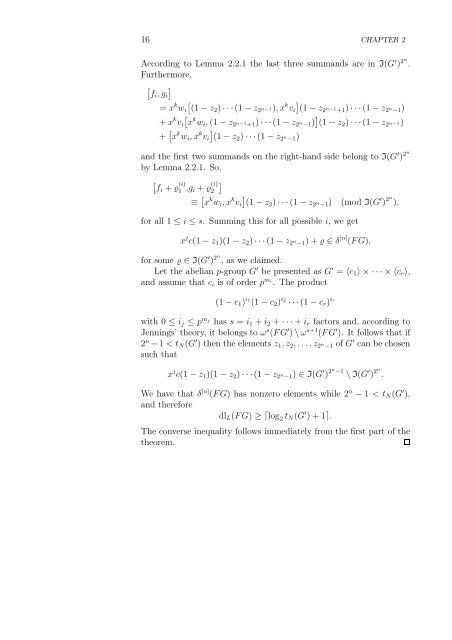On the Derived Length of Lie Solvable Group Algebras
On the Derived Length of Lie Solvable Group Algebras
On the Derived Length of Lie Solvable Group Algebras
You also want an ePaper? Increase the reach of your titles
YUMPU automatically turns print PDFs into web optimized ePapers that Google loves.
16 CHAPTER 2<br />
According to Lemma 2.2.1 <strong>the</strong> last three summands are in I(G ′ ) 2n.<br />
Fur<strong>the</strong>rmore,<br />
<br />
fi, gi<br />
= x k <br />
wi (1 − z2) · · · (1 − z2n−1), x k <br />
vi (1 − z2n−1 +1) · · · (1 − z2n−1) <br />
k<br />
x wi, (1 − z2n−1 +1) · · · (1 − z2n−1) (1 − z2) · · · (1 − z2n−1) + x k vi<br />
+ x k wi, x k <br />
vi (1 − z2) · · · (1 − z2n−1) and <strong>the</strong> first two summands on <strong>the</strong> right-hand side belong to I(G ′ ) 2n<br />
by Lemma 2.2.1. So,<br />
<br />
fi + ϱ (i)<br />
1 ,gi + ϱ (i) <br />
2<br />
≡ x k wi, x k <br />
vi (1 − z2) · · · (1 − z2n−1) (mod I(G ′ ) 2n<br />
),<br />
for all 1 ≤ i ≤ s. Summing this for all possible i, we get<br />
x j c(1 − z1)(1 − z2) · · · (1 − z2 n −1) + ϱ ∈ δ [n] (F G),<br />
for some ϱ ∈ I(G ′ ) 2n,<br />
as we claimed.<br />
Let <strong>the</strong> abelian p-group G ′ be presented as G ′ = 〈c1〉 × · · · × 〈cr〉,<br />
and assume that ci is <strong>of</strong> order pmi . The product<br />
(1 − c1) i1 (1 − c2) i2 · · · (1 − cr) ir<br />
with 0 ≤ ij ≤ p mj has s = i1 + i2 + · · · + ir factors and, according to<br />
Jennings’ <strong>the</strong>ory, it belongs to ω s (F G ′ ) \ ω s+1 (F G ′ ). It follows that if<br />
2 n − 1 < tN(G ′ ) <strong>the</strong>n <strong>the</strong> elements z1, z2, . . . , z2 n −1 <strong>of</strong> G ′ can be chosen<br />
such that<br />
x j c(1 − z1)(1 − z2) · · · (1 − z2 n −1) ∈ I(G ′ ) 2n −1 \ I(G ′ ) 2 n<br />
.<br />
We have that δ [n] (F G) has nonzero elements while 2 n − 1 < tN(G ′ ),<br />
and <strong>the</strong>refore<br />
dlL(F G) ≥ ⌈log 2 tN(G ′ ) + 1⌉.<br />
The converse inequality follows immediately from <strong>the</strong> first part <strong>of</strong> <strong>the</strong><br />
<strong>the</strong>orem.


